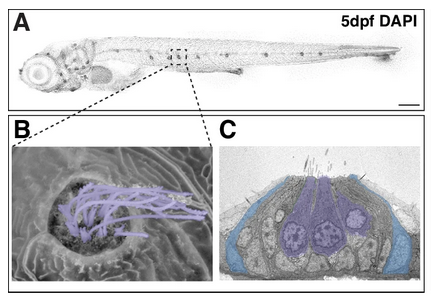The inner ear is mainly derived from a specific group of cells called the otic placode. The otic placode is one of many embryonic structures emerging from the pre-placodal ectoderm (PPE) that give rise to sensory structures in the body. However, the molecular dynamics underlying how the PPE develops into regions destined for different sensory structures are not well understood.
Most studies on the early development of sensory placodes have been undertaken in non-mammalian organisms. The small sizes and difficulty in culturing mammalian embryos contribute to technical obstacles for studying the development of placodes using traditional techniques such as tissue grafting.
Alternative models for studying early development in mammals, especially for scarce tissue types such as placodes, are in need. Stem cell-based systems have shown potential in advancing our understanding of mammalian development. As reported in the journal Stem Cells in January 2023, Pei-Ciao Tang, Ph.D., and team explored the potential of the stem cell-derived inner ear organoid system for studying early mammalian placode development.
Stem cell-derived inner ear organoids, with nuclei in blue, hair cells in red, and supporting cells in green. Credit: Tang et al./Stem Cells
Several different signaling pathways that transmit information to cells are used during early organoid development, with the Wnt pathway used in later stages. However, Wnt signaling pathways also play dynamic and critical roles earlier in development, before a particular placode becomes specified (otic for ears, lens for eyes, etc.). This study specifically looked at how Wnt signaling pathways affect patterning of PPE during the early stage of differentiation.
We found that early Wnt activation significantly enhances the induction of hair cell-bearing inner ear organoids through properly patterning PPE toward otic placodes. The resulting high yield of otic progenitor cells (and later hair cells) will benefit future inner ear organoid applications, such as high-throughput drug screening and cell therapy.
Furthermore, we comprehensively profiled gene expression across various Wnt levels at different times, and these data demonstrate Wnt-mediated induction of cells in organoids and provides valuable information to the fields of stem cell, inner ear, and developmental biology of cranial sensory systems.
This is adapted from the January 2023 paper in the journal Stem Cells. A 2020 and 2022 Emerging Research Grants (ERG) scientist, Pei-Ciao Tang, Ph.D., is a research assistant professor in the department of otolaryngology at the University of Miami Miller School of Medicine. The paper’s coauthors include Hearing Restoration Project member Andy Groves, Ph.D., a 1996–1997 and 2012 ERG scientist, and Xue Zhong Liu, Ph.D., a 2000–2002 ERG scientist.








Two people have the same audiogram results but one can follow conversations at a loud party, while the other feels completely lost and overwhelmed. We set out to examine why.